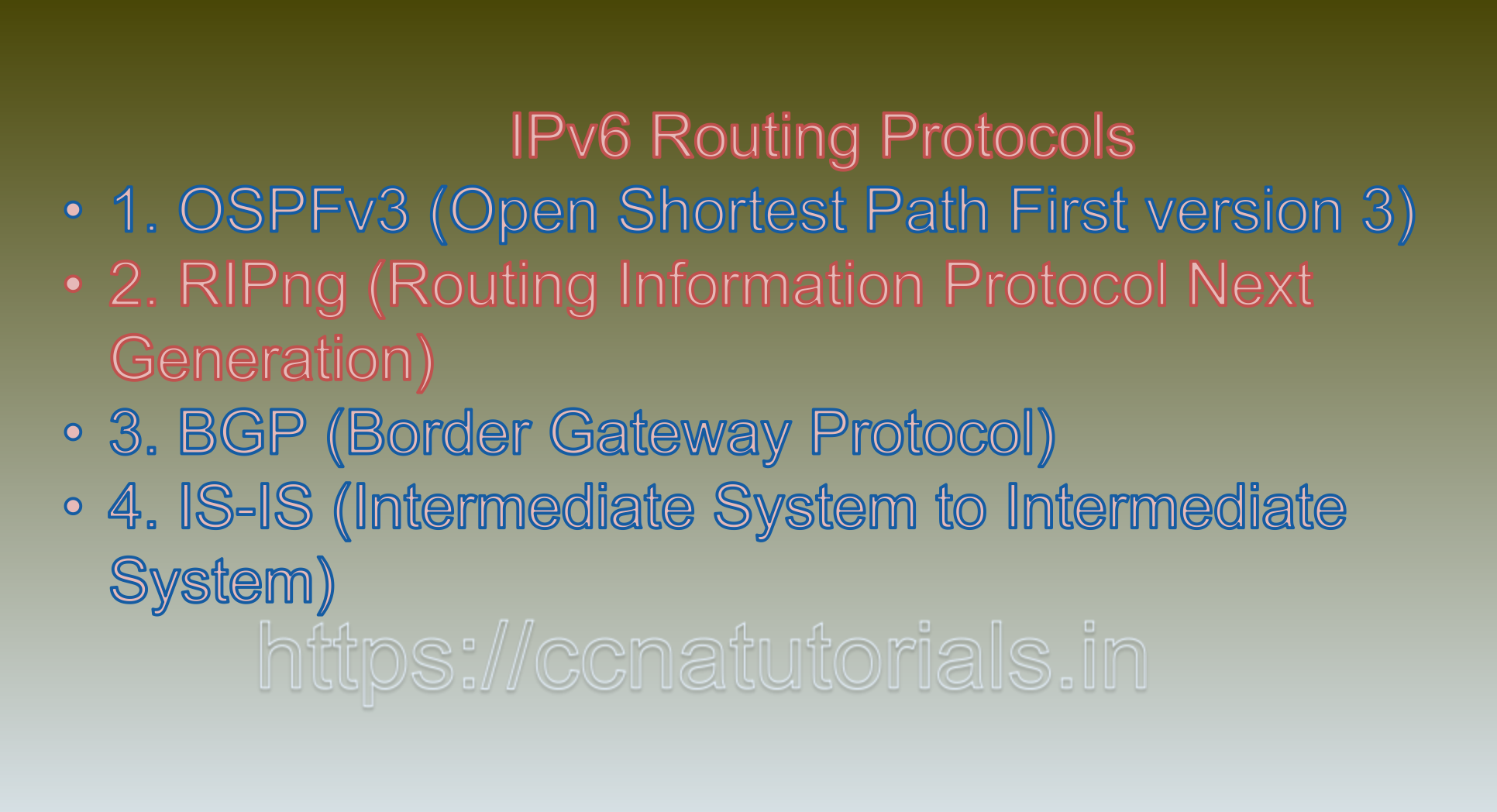Contents of this article
In this article, I describe IPv6 Routing and Forwarding in simple language with examples. In the realm of networking, IPv6 (Internet Protocol version 6) ushers in a new era of addressing and routing capabilities. As the successor to IPv4, IPv6 not only addresses the looming shortage of IP addresses but also brings enhancements in routing and forwarding mechanisms that shape the way data packets traverse the vast expanses of the Internet. This article delves into the intricacies of IPv6 routing and forwarding, exploring the fundamental concepts, routing protocols, and forwarding mechanisms that underpin the operation of this next-generation networking protocol. Routing and forwarding of IPv6 is the term used for flow of data packets in a network. Lets see IPv6 routing fundamentals as a part of IPv6 Routing and Forwarding.
IPv6 Routing Fundamentals:
Routing is the process by which data packets are directed from their source to their destination across interconnected networks. IPv6 routing builds upon the principles established by IPv4 but introduces refinements and improvements tailored to the modern networking landscape.
1. IPv6 Addressing:
IPv6’s 128-bit address space allows for a virtually unlimited number of unique IP addresses. The hexadecimal representation of IPv6 addresses, along with the use of colons, facilitates efficient addressing and route aggregation.
2. Address Types:
IPv6 introduces multiple address types, including unicast (single destination), multicast (multiple destinations), and anycast (nearest destination). Each type serves specific routing and communication needs.
3. Routing Table:
Just like in IPv4, routers maintain a routing table containing information about network destinations and the best paths to reach them. However, IPv6 routing tables often support longer prefixes due to the expanded address space.
IPv6 Routing Protocols:
IPv6 supports a variety of routing protocols that facilitate the exchange of routing information among routers, enabling them to make informed decisions about how to forward data packets. Some prominent routing protocols in the IPv6 context include:
1. OSPFv3 (Open Shortest Path First version 3):
OSPFv3 is an interior gateway protocol used for routing within autonomous systems (AS). It accommodates IPv6 addresses and prefixes, ensuring seamless integration with IPv6 networks.
2. RIPng (Routing Information Protocol Next Generation):
RIPng is a distance-vector routing protocol that supports IPv6. It shares routing information between neighboring routers, making it suitable for small to medium-sized networks.
3. BGP (Border Gateway Protocol):
BGP is an exterior gateway protocol employed for inter-domain routing on the Internet. BGP-4 has been extended to support IPv6, enabling efficient routing between different autonomous systems.
4. IS-IS (Intermediate System to Intermediate System):
IS-IS is another interior gateway protocol that has been extended to support IPv6. It is commonly used in larger service provider networks.
IPv6 Forwarding Mechanisms in the terms of IPv6 Routing and Forwarding:
Forwarding is the process of selecting the best path for data packets through a network based on routing information. IPv6 incorporates advanced forwarding mechanisms that contribute to efficient and robust data delivery:
1. Neighbor Discovery Protocol (NDP):
NDP is a vital component of IPv6’s addressing and forwarding mechanisms. It facilitates the discovery of neighboring devices on the same link, enabling efficient address resolution and neighbor interaction.
2. Router Advertisement (RA) and Router Solicitation (RS):
RAs are periodically sent by routers to advertise their presence and provide configuration information to neighboring hosts. RS messages are used by hosts to request RAs, ensuring timely updates.
3. Fragmentation and Path MTU Discovery:
IPv6 routers do not perform packet fragmentation. Instead, they rely on the sending host to discover the path Maximum Transmission Unit (MTU) and adjust packet sizes accordingly.
4. Hop-by-Hop and Destination Options Headers:
These extension headers enable routers and hosts to add specialized information to IPv6 packets, enhancing the flexibility of forwarding and processing.

IPv6 Routing and Forwarding Challenges:
While IPv6 brings significant improvements to routing and forwarding, it also presents its own set of challenges:
1. Transition from IPv4:
During the transition from IPv4 to IPv6, networks may operate in a dual-stack mode, supporting both protocols. This introduces complexity and potential compatibility issues.
2. Configuration and Management:
IPv6 routers and devices must be correctly configured and managed to ensure proper routing and forwarding. Misconfigurations can lead to connectivity issues.
3. Security:
IPv6 networks introduce new security considerations, and network administrators must be diligent in implementing measures to protect against potential threats.
4. Interoperability:
As IPv6 adoption continues, ensuring seamless interoperability between IPv6 and legacy IPv4 networks is crucial to maintaining uninterrupted communication.
Configuration of IPv6 routing and forwarding
Certainly! Here’s a simplified example of configuring IPv6 routing and forwarding using Cisco IOS commands. Please note that actual configurations can vary based on your network equipment and requirements.
Topology:
For this example, let’s consider a basic network topology with two routers and two subnets:
[Router1]
/ \
[Subnet 1] [Subnet 2]
\ /
[Router2]
Step 1: Basic Interface Configuration:
Assuming you’re using Cisco routers, configure the interfaces for each subnet on both routers:
On Router1:
bash
interface GigabitEthernet0/0
IPv6 address 2001:db8:1::1/64
interface GigabitEthernet0/1
IPv6 address 2001:db8:2::1/64
On Router2:
bash
interface GigabitEthernet0/0
IPv6 address 2001:db8:2::2/64
interface GigabitEthernet0/1
IPv6 address 2001:db8:3::1/64
Step 2: Enable IPv6 Routing:
Enable IPv6 routing on both routers to ensure they can forward traffic between subnets:
On Router1:
bash
IPv6 unicast-routing
On Router2:
bash
IPv6 unicast-routing
Step 3: Configure Static Routes:
In this example, we’ll configure static routes to ensure traffic can flow between the subnets:
On Router1:
bash
IPv6 route 2001:db8:3::/64 2001:db8:2::2
On Router2:
bash
IPv6 route 2001:db8:1::/64 2001:db8:2::1
Step 4: Verify Configuration:
Use the `show IPv6 interface brief` and `show IPv6 route` commands to verify the interface and routing configurations on both routers. Ensure that each router has routes to the other subnets and that the interfaces are up and assigned the correct IPv6 addresses.
Step 5: Testing:
With the configurations in place, you should be able to ping devices in different subnets from each router. For instance, from Router1, you can try pinging an interface in Subnet 2:
bash
Router1# ping 2001:db8:2::2
Step 6: Neighbor Discovery Protocol (NDP):
IPv6 uses NDP for neighbor discovery and address resolution. Ensure that NDP is enabled on interfaces using the `IPv6 nd autoconfig` command:
On Router1:
bash
interface GigabitEthernet0/0
IPv6 nd autoconfig
interface GigabitEthernet0/1
IPv6 nd autoconfig
On Router2:
bash
interface GigabitEthernet0/0
IPv6 nd autoconfig
interface GigabitEthernet0/1
IPv6 nd autoconfig
Step 7: Verify Neighbor Relationships:
Use the `show IPv6 neighbors` command to verify that neighbor relationships have been established between devices on the same subnet.
Remember that this is a basic example, and in a real-world scenario, you may need to consider additional configurations, routing protocols (such as OSPFv3 or BGP), security measures, and more advanced features to ensure a robust and secure IPv6 network.
Conclusion for IPv6 Routing and Forwarding:
IPv6 routing and forwarding lie at the core of the modern Internet’s operation, enabling data to traverse complex networks and reach their intended destinations. With its expanded address space, refined addressing schemes, and advanced routing protocols, IPv6 paves the way for a more scalable, efficient, and interconnected digital world. As organizations embrace IPv6 and navigate the challenges of migration and integration, a solid understanding of IPv6 routing and forwarding is essential for building robust and future-ready networks that can support the demands of a rapidly evolving digital landscape.






